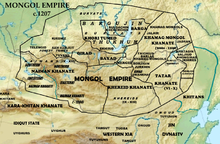Khongirad
| History of Mongolia |
|---|
 |

The Khongirad
During the Yuan dynasty they were given the title Lu Wang ("Prince of Lu"; Chinese: 鲁王), and a few Khongirads migrated west into the territory of modern Uzbekistan and Turkistan Region where they became governors of Khwarazm and were known as the Sufi dynasty. After a brief period as independent rulers, they were subjected by Timur.
Origin
The Khongirads are often identified as the descendants of the ancient Wuku/Wugu tribe in
Many names of the 12th century's Hongirads and their subtribes have Mongol origin:[4][5]
- Dei Setsen — tsetsen (wise)
- Jurluq Mergen — zörlög (path) mergen (wise). (See Merkit)
- Quba Shira — goo (beautiful) shar (yellow). In the 1680s ).
Subtribes
- Hongirad — khun (swan), khungiin (swan's), ard (person); swan person. Swan is one of Mongol totems. (See Oirats).
- Qongliyuts — Khonkhluud; khonkh (bell), "iud" or "uud" is plural suffix.
- Gorlos — Modern Southern Mongolsubgroup
- Ikires — Ikhires: ikh (great), ikhes (chief, noble)
- Karanut — Kharnuud: khar (black), "iud" or "uud" is plural suffix
- Olkhunut — Olkhunuud, "uud" is plural suffix. They have three subgroups:
- Alag aduutan: alag (piebald), aduutan (horse herder); piebald horse herder.
- Shar khonit: shar (yellow), khoni (sheep); yellow sheep breeder.
- Ulaan zalaat: ulaan (red), zalaa (tassel); person who wears hat with red tassel.[citation needed] Today, Mongols call themselves "red-tasseled Mongols" because Mongols wear hat with red tassel and they adore fire.[citation needed] Fire is a general symbol of eternal growth, wealth, and success and a figure of fire is used in Mongolian flag, coat of arms and Soyombo symbol. The three tongues of the flame represent the past, present, and future.[citation needed]
Shamanic practices continue in present-day
Relationship with the Mongols: The Legend of Ergune Khun
According to Mongol legend, two warriors named Kiyan (
Consort tribe

In addition to having a shared ancestry with the Mongols in general, the Hongirads also shared ancestors with the Mongol royal line, whose originator, Alan Qo'a, was a woman of the Kharlas clan, an offshoot of the Khongirads founded by the legendary Miser Ulug. Down to the 12th century, Mongol rulers such as
After the death of the last Yuan emperor,
.Transoxiana
During the 18th century, the basins of the
Descendants are found among the people in
Kazakhstan
Currently a
Rule of Khiva
They ruled the Khiva khanate from 1763 to 1920.
Notes
References
- ^ a b c The Chinese Social and Political Science Review, Volume 20, pub Chinese Social and Political Science Association, 1937, p494.
- ^ a b Central Asia: Foundations of Change, by R. D. McChesney, pub Darwin Press, 1996, p202.
- ^ Хонгирад аймаг mongol.undesten.mn Archived 2016-03-04 at the Wayback Machine (Mongolian)
- ^ a b M. Sanjdorj, History of the Mongolian People's Republic, Volume I, 1966
- ^ The Secret History of the Mongols
- ^ Shamanism in China: bibliography, by Barend ter Haar, who teaches at the Institute for Chinese Studies. Mentions that a book called Popular Religion and Shamanism includes "as well as three studies of shamanism among non-Han cultures (Mongol, Tungusic and Daba)".
- ^ Local Belief Systems Archived 2012-11-06 at the Wayback Machine, by Professor Mark Bender. Ohio State University.
- ^ 1999 Copyright Agency BRIF Central Asia, Author A.I.SOBAKIN
- ^ E. E. Ashirbekov, D. M. Botbaev, A. M. Belkozhaev, A. O. Abayldaev, A. S. Neupokoeva, J. E. Mukhataev, B. Alzhanuly, D. A. Sharafutdinova, D. D. Mukushkina, M. B. Rakhymgozhin, A. K. Khanseitova, S. A. Limborska, N. A. Aytkhozhina, "Distribution of Y-Chromosome Haplogroups of the Kazakh from the South Kazakhstan, Zhambyl, and Almaty Regions." Reports of the National Academy of Sciences of the Republic of Kazakhstan, ISSN 2224-5227, Volume 6, Number 316 (2017), 85 - 95.
- ^ a b c Boris Malyarchuk, Miroslava Derenko, Galina Denisova, et al., "Phylogeography of the Y-chromosome haplogroup C in northern Eurasia." Annals of Human Genetics (2010) 74, 539–546. doi: 10.1111/j.1469-1809.2010.00601.x
- ^ a b c d Tatiana M. Karafet, Ludmila P. Osipova, Olga V. Savina, Brian Hallmark, and Michael F. Hammer, "Siberian genetic diversity reveals complex origins of the Samoyedic‐speaking populations." American Journal of Human Biology, 08 November 2018. https://doi.org/10.1002/ajhb.23194
- ^ V. N. Kharkov, K. V. Khamina, O. F. Medvedeva, et al., "Gene Pool of Buryats: Clinal Variability and Territorial Subdivision Based on Data of Y-Chromosome Markers." ISSN 1022-7954, Russian Journal of Genetics, 2014, Vol. 50, No. 2, pp. 180–190. DOI: 10.1134/S1022795413110082
- ^ a b Natalia Balinova, Helen Post, Alena Kushniarevich, et al., "Y-chromosomal analysis of clan structure of Kalmyks, the only European Mongol people, and their relationship to Oirat-Mongols of Inner Asia." European Journal of Human Genetics 11 April 2019. https://doi.org/10.1038/s41431-019-0399-0
- ^ Boris Malyarchuk, Miroslava Derenko, Galina Denisova, et al., "Y-chromosome diversity in the Kalmyks at the ethnical and tribal levels." Journal of Human Genetics (2013) 58, 804–811; doi:10.1038/jhg.2013.108; published online 17 October 2013.
